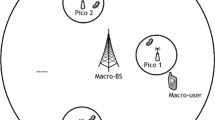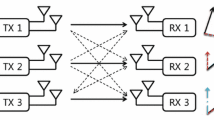Abstract
One of the techniques that has been recently identified for dealing with multi-user interference (MUI) in future communications systems is base station (BS) cooperation or joint processing. However, perfect MUI cancellation with this technique demands severe synchronization requirements, perfect and global channel state information (CSI), and an increased backhaul and signaling overhead. In this paper, we consider a more realistic layout with the aim of mitigating the MUI, where only local CSI is available at the BSs. Due to synchronization inaccuracies and errors in the channel estimation, the system becomes partially asynchronous. In the downlink of wideband code division multiple access based systems, this asynchronism stands for the loss of the orthogonality of the spreading codes allocated to users and thus, for an increase in the MUI level of the system. In this contribution, we propose a framework for mitigating the MUI which builds in three main steps: definition of a cooperation area based on the channel characteristics, statistical modeling of the average MUI power experienced by each user and a specific spreading code allocation scheme for users served with joint processing. This code allocation assigns spreading codes to users in such a way that minimum average cross-correlation between active users can be achieved. Interestingly, these steps can be performed with a limited amount of extra feedback from the user’s side.






Similar content being viewed by others
Notes
CSI between one BS and all the users that is serving.
The cluster remains fixed in time.
The orthogonality factor is defined as the instantaneous fraction of received downlink power converted by multipath into interference.
Area where BS cooperation is actually performed.
Since the system model considers linear arrays of \(N_a\) and \(N_r\) antennas with half of the wavelength separation co-located at the BS and user device, respectively, we can assume that the different angles of arrival of the received signal are common to all the antennas [40], and so are the propagation delays \(\tau _{m,k,l}\).
As remarked in the previous section, the numbering of the BSs is not fixed, but it depends on the composite channel state of a given user: BS1, in addition of being the serving BS for user \(m\), is that whose \(\tau _{m,k,1}\) is the minimum.
OVSF codes have been considered throughout the paper, but average MUI contribution could be calculated as stated in the previous section for any set of channelization codes.
OVSF codes are sequentially assigned from 1 to \(N\) through the OVSF layer.
References
Jungnickel, V., Manolakis, K., Zirwas, W., Panzner, B., Braun, V., Lossow, M., et al. (2014). The role of small cells, coordinated multipoint, and massive MIMO in 5G. IEEE Communications Magazine, 52(5), 44–50.
Hossain, E., & Lei, Z. (2013). Multicell cooperation. IEEE Wireless Communications, special issue, 20(1).
Karakayali, M. K., Foschini, G. J., & Valenzuela, R. A. (2006). Network coordination for spectrally efficient communications in cellular systems. IEEE Wireless Communications, 13(4), 56–61.
Du, Q., & Zhang, X. (2011). Base-station selection for QoS provisioning over distributed multi-user MIMO links in wireless networks. In Proceedings of IEEE INFOCOM.
3GPP TR 36.819, 3rd Generation Partnership Project; Technical Specification Group Radio Access Network; Coordinated multi-point operation for LTE physical layer aspects (Release 11), (2011).
3GPP Release 11, Overview of 3GPP Release 11 V0.2.0 (2014).
Nokia Solutions and Networks, LTE-Advanced (Release 12 and Beyond). (2014). http://networks.nokia.com/file/29961/lte-advanced-rel12-and-beyond.
Rusek, F., Persson, D., Lau, B. K., Larsson, E. G., Marzetta, T. L., Edfors, O., et al. (2013). Scaling up MIMO: Opportunities and challenges with very large arrays. IEEE Signal Processing Magazine, 30(1), 40–60.
Nokia Solutions and Networks, Looking ahead to 5G. (2013). http://networks.nokia.com//file/28771/nsn-5g-white-paper.
Ericsson, HSPA Evolution—beyond 3GPP Release 10. (2011). http://www.3g4g.co.uk/Hspa/HSPAE_WP_1107_Ericsson.
Nokia Siemens Networks, Long Term HSPA Evolution meets ITU IMT-Advanced requirements. (2012). http://networks.nokia.com/system/files/document/nokia_siemens_networks_long_term_hspa_evolution_meets_itu_imt-advanced_requirements_18_04_12_online.pdf.
Qualcomm Incorporated, HSPA+ Advanced Smart Networks: Multipoint Transmission. (2011). https://www.qualcomm.com/invention/research/projects/hspa-advanced/multiflow.
Nokia Solutions and Networks, Taking HSPA to the next level with Release 12 and Beyond. (2014). http://networks.nokia.com/file/30801/taking-hspa-to-the-next-level-with-release-12-and-beyond.
3GPP TSG-RAN, RP-101439, Proposed study item on HSDPA multipoint transmission. (2010).
3GPP TR 25.872, 3rd Generation Partnership Project; Technical Specification Group Radio Access Network; High Speed Packet Access (HSDPA) multipoint transmission (Release 11). (2011).
3GPP TSG-RAN, RP-111375, HSDPA Multiflow data transmission. (2011).
3GPP TSG-RAN WG1, R1–104913, Multi-cell transmission techniques for HSDPA. (2010).
3GPP TSG-RAN WG1, R1–110123, Candidate schemes for multi-point HSDPA. (2011).
Hytonen, V., Puchko, O., Hohne, T., & Chapman, T. (2011). High-speed single-frequency network for HSDPA. In Proceedings of IEEE Swedish Communication Technologies Workshop.
Yang, W., Chang, Y., Liu, S., & Yang, D. (2011). Efficient multi-point transmission scheme for HSDPA networks. In Proceedings of IEEE Vehicular Technology Conference (VTC-Fall).
Petrov, D., Repo, I., & Lampinen, M. (2012). Overview of single frequency multipoint transmission concepts for HSDPA and performance evaluation of intra-site multiflow aggregation scheme. In Proceedings of IEEE Vehicular Technology Conference (VTC-Spring).
Yaver, A., Marsch, P., Pawlak, K., & Moya, F. S. (2012). On the joint usage of MIMO and multiflow in evolved HSPA networks. In Proceedings of IEEE International Conference on Communications (ICC).
Qualcomm Technologies. HSPA+ Multiflow. Solution for cell edge performance improvement and dynamic load balancing. (2014). https://www.qualcomm.com/media/documents/files/hspa-multiflow.pdf.
Nokia Solutions and Networks. (2014). Setting up HSPA+ heterogenous networks for the best customer experience. http://networks.nokia.com/file/31256/setting-up-hspa-heterogeneous-networks-for-the-best-customer-experience.
Venkatesan, S. (2007). Coordinating base stations for greater uplink spectral efficiency in a cellular network. In Proceedings of IEEE International Symposium on Personal, Indoor and Mobile Radio Communications (PIMRC).
Boccardi, F., & Huang, H. (2007). Limited downlink network coordination in cellular networks. In Proceedings of IEEE International Symposium on Personal, Indoor and Mobile Radio Communications (PIMRC).
Papadogiannis, A., Gesbert, D., & Hardouin, E. (2008). A dynamic clustering approach in wireless networks with multi-cell cooperative processing. In Proceedings of IEEE International Conference on Communications (ICC).
Boccardi, F., Huang, H., & Alexiou, A. (2008). Network MIMO with reduced backhaul requirements by MAC coordination. In Proceedings of IEEE Asilomar Conference on Signals, Systems and Computers.
Zhang, H., Mehta, N. B., Molisch, A. F., Zhang, J., & Dai, H. (2008). Asynchronous interference mitigation in cooperative base station systems. IEEE Transactions on Wireless Communications, 7(1), 155–165.
Gee, S. B., Lei, Z., & Chew, Y. H. (2011). Cooperative multiuser MIMO precoding design for asynchronous interference mitigation. In Proceedings of IEEE Global Telecommunications Conference workshops (GLOBECOM).
Medjahdi, Y., Terre, M., Le Ruyet, D., Roviras, D., & Dziri, A. (2011). Performance analysis of asynchronous OFDM/FBMC based multi-cellular networks. IEEE Transactions on Wireless Communications, 10(8), 2630–2639.
Zarikoff, B. W., & Cavers, J. K. (2010). Coordinated multi-cell systems: Carrier frequency offset estimation and correction. IEEE Journal on Selected Areas in Communications, 28(9), 1490–1501.
Awoniyi, O., Mehta, N. B., & Greenstein, L. J. (2003). Characterizing the orthogonality factor in WCDMA downlinks. IEEE Transactions on Wireless Communications, 2(4), 621–625.
Mehta, N. B., Greenstein, L. J., Willis, T. M., & Kostic, Z. (2003). Analysis and results for the orthogonality factor in WCDMA downlinks. IEEE Transactions on Wireless Communications, 2(6), 1138–1149.
Mehta, N. B., Molisch, A. F., & Greenstein, L. J. (2006). Macrocell-wide behavior of the orthogonality factor in WCDMA downlinks. IEEE Transactions on Wireless Communications, 5(12), 3394–3399.
Botella, C., Piñero, G., González, A., & de Diego, M. (2006). Spreading sequence assignment in WCDMA for distributed antenna arrays based on interference knowledge. In Proceedings of IEEE Workshop on Signal Processing Advances in Wireless Communications (SPAWC).
Chang, Y.-J., Tao, Z., Zhang, J., & Kuo, C.-C. J. (2008). A graph-based approach to multi-cell OFDMA downlink resource allocation. In Proceedings of IEEE Global Telecommunications Conference (GLOBECOM).
Pi\(\tilde{{\rm n}}\)ero, G., Botella, C., González, A., de Diego, M., & Cardona, N. (2004). Downlink power control and beamforming for a cooperative wireless system. In Proceedings of IEEE International Symposium on Personal, Indoor and Mobile Radio Communications (PIMRC).
Botella, C., Piñero, G., González, A., & de Diego, M. (2008). Coordination in a multi-cell multi-antenna multi-user W-CDMA system: A beamforming approach. IEEE Transactions on Wireless Communications, 7(11), 4479–4485.
3GPP TR 25.996, 3rd Generation Partnership Project; Technical Specification Group Radio Access Network; Spatial channel model for Multiple Input Multiple Output (MIMO) simulations (Release 11). (2012).
Cheun, K. (1997). Performance of direct-sequence spread-spectrum RAKE receivers with random spreading sequences. IEEE Transactions on Communications, 45(9), 1130–1143.
Gkonis, P. K., Tsoulos, G. V., & Kaklamani, D. I. (2011). Performance evaluation of MIMO-WCDMA cellular networks in multiuser frequency selective fading environments. Wireless Communications and Mobile Computing, 13(1), 72–84.
Bottomley, G. E., Ottosson, T., & Wang, Y.-P. E. (2000). A generalized RAKE receiver for interference suppression. IEEE Journal on Selected Areas in Communications, 18(8), 1536–1545.
Fulghum, T. L., Cairns, D., Cozzo, C., Wang, Y.-P. E., & Bottomley, G. E. (2009). Adaptive generalized rake reception in DS-CDMA systems. IEEE Transactions on Wireless Communications, 8(7), 3464–3474.
Wang, C.-X., Hong, X., Wu, H., & Xu, W. (2007). Spatial-temporal correlation properties of the 3GPP spatial channel model and the Kronecker MIMO channel model. EURASIP Journal on Wireless Communications and Networking, Article ID 39871.
Li, J., Svensson, T., Botella, C., Eriksson, T., Xu, X., & Chen, X. (2011). Joint scheduling and power control in coordinated multi-point clusters. In Proceedings of IEEE Vehicular Technology Conference (VTC-fall).
Botella, C., Svensson, T., Xu, X., & Hui, Z. (2010). On the performance of joint processing schemes over the cluster area. In Proceedings of IEEE Vehicular Technology Conference (VTC-spring).
Papadogiannis, A., Bang, H. J., Gesbert, D., & Hardouin, E. (2008). Downlink overhead reduction for multi-cell cooperative processing enabled wireless networks. In Proceedings of IEEE International Symposium on Personal, Indoor and Mobile Radio Communications (PIMRC).
Mennerich, W., & Zirwas, W. (2010). Implementation issues of the partial CoMP concept. In Proceedings of IEEE International Symposium on Personal, Indoor and Mobile Radio Communications (PIMRC).
3GPP TSG-RAN WG1, R1–092657, Impact of propagation attenuations and delays of CoMP composite. (2009).
Minn, T., & Siu, K.-Y. (2000). Dynamic assignment of orthogonal variable-spreading-factor codes in W-CDMA. IEEE Journal on Selected Areas in Communications, 18(8), 1429–1440.
Tseng, Y.-C., & Chao, C.-M. (2002). Code placement and replacement strategies for wideband CDMA OVSF code tree management. IEEE Transactions on Mobile Computing, 1(4), 293–302.
Dell’Amico, M., Merani, M. L., & Maffioli, F. (2004). A tree partitioning dynamic policy for OVSF codes assignment in wideband CDMA. IEEE Transactions on Wireless Communications, 3(4), 1013–1017.
Ulukus, S., & Yates, R. D. (2001). Iterative construction of optimum signature sequence sets in synchronous CDMA sytems. IEEE Transactions on Information Theory, 47(5), 1989–1998.
Chen, J.-T., Papadias, C., & Foschini, G. J. (2004). Space-time dynamic signature assignment for the reverse link of DS-CDMA systems. IEEE Transactions on Communications, 52(1), 120–129.
Gao, L., & Wong, T. F. (2004). Power control and spreading sequence allocation in a CDMA forward link. IEEE Transactions on Information Theory, 50(1), 105–124.
Papadogiannis, A., Hardouin, E., & Gesbert, D. (2008). A framework for decentralising multi-cell cooperative processing on the downlink. In Proceedings of IEEE Global Telecommunications Conference (GLOBECOM).
Skjevling, H., Gesbert, D., & Hjørungnes, A. (2008). Low-complexity distributed multibase transmission and scheduling. EURASIP Journal on Advances in Signal Processing, Article ID 741593.
Rashid-Farrokhi, F., Ray Liu, K. J., & Tassiulas, L. (1998). Transmit beamforming and power control for cellular wireless systems. IEEE Journal on Selected Areas in Communications, 16(8), 1437–1450.
Acknowledgments
C. Botella’s work has been partially supported by the Spanish MINECO Grants CONSOLIDER-INGENIO 2010 CSD 2008-00010 COMONSENS and RACHEL TEC2013-47141-C4-4-R. G. Piñero and M. de Diego’s work has been supported by European Union ERDF and Spanish Government through TEC2012-38142-C04 Project, and Generalitat Valenciana through PROMETEOII/2014/003 Project.
Author information
Authors and Affiliations
Corresponding author
Rights and permissions
About this article
Cite this article
Botella, C., Piñero, G. & de Diego, M. Multi-user interference mitigation under limited feedback requirements for WCDMA systems with base station cooperation. Telecommun Syst 61, 543–557 (2016). https://doi.org/10.1007/s11235-015-0011-z
Published:
Issue Date:
DOI: https://doi.org/10.1007/s11235-015-0011-z




